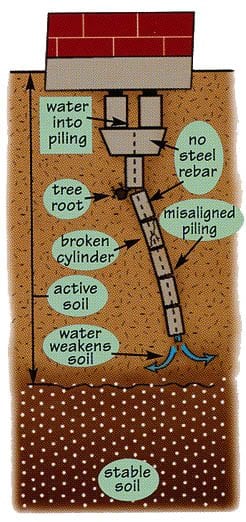There are several methods of foundation repair, and many companies use a method called Pressed Pilings or Pressed Piles. Pressed Pilings, with or without Inserts, can be done with concrete or steel cylinders. This method is common because it is significantly cheaper to install than the Bell Bottom Pier method. This raises their profit margin, and a lower cost appeals to most homeowners. They don’t realize, however, that they’ll likely have problems in the future. There are many problems with pressed pilings. Pressed Piling methods have major disadvantages, and every homeowner should get the facts before hiring a foundation repair company.
What are the problems of pressed pilings as a foundation repair method? Here are 3 significant issues to consider:
1. Depth – Pressed pilings use a series of cylinders that are pressed into the soil using the weight of the home itself to drive them into the ground. These cylinders will reach a point where they cannot be driven any further based on the pressure from the home’s weight. This point is called the “point of refusal,” and it may not be the point where the soil actually becomes stable. It may only be the point where the home’s weight ceases to drive the pilings any further. For this reason, the pilings may not be deep enough to offer the home stable support. This makes the home subject to the further movement, just as it was before the work was done.

3. Alignment – In the same way that the cylinders can break, pressed pilings can also be improperly aligned during the installation. If the cylinder hits a rock, a tree root, or any other obstruction when being driven into the soil, the cylinders can be placed at an incorrect angle, as the obstruction redirects their alignment. This misalignment cannot be seen until it’s too late. If the pilings aren’t installed at the proper angles, they become virtually worthless, because they offer no support. Misalignment, in fact, is the most frequent problem, and most important disadvantage to be aware of.
We believe the pressed piling method of foundation repair has significant disadvantages. We encourage homeowners to review what engineers have to say about the problems of pressed pilings as well. For these reasons, Dawson Foundation Repair installs only Bell Bottom Piers for homeowners and commercial property owners.
We believe Bell Bottom Piers have far more advantages over any other method of foundation repair. Bell Bottom Piers is the Highest Quality foundation repair method available in Texas. Bell Bottom Piers have a Load Capacity that is 5.8 times greater than the cheaper stacked concrete cylinders methods. Bell Bottom Piers have a foot or “footprint” for stability that is 13 times greater than the cheaper stacked concrete cylinders methods.
The structural engineers at A-1 Engineering have a very blunt opinion about these cheaper stacked concrete cylinder methods and have called them “temporary” and “almost useless.”
